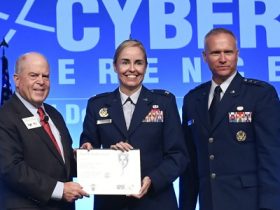A small unmanned surface vessel called the Lightfish made a new milestone for USVs when it arrived in Portugal just over two months after being launched by the U.S. Navy in June.
The fully autonomous Lightfish is a small solar-powered craft manufactured by Seasats. Its solar panels operate and store energy even in cloudy weather, and the craft is equipped with a battery and generator that can extend its range for over 500 nautical miles in emergency situations. The Lightfish is able to detect obstacles in its path and can respond to them autonomously or be maneuvered remotely.
The Unmanned Naval Innovation Team of the Naval Information Warfare Center Atlantic launched the Lightfish from Sullivan’s Island, South Carolina, in late June with a destination of Troia, Portugal. During its journey, the craft operatively autonomously but was monitored across various naval commands and areas of responsibility. The Lightfish’s journey was supported by Commander, Task Force 66 of the U.S. 6th Fleet, an all-domain task force focusing on autonomous systems and often nicknamed “the Black Sea Battle Lab.”
“At least twice per day, we would change command and control and oversight of this vessel between various Navy numbered fleets,” Michael Grass, UNIT’s lead scientist and program manager, said in a service release. “Every morning and every evening, there was essentially a change of command, and ownership, and oversight of this particular vessel for the entirety of the duration.”
The Lightfish beat a previous USV record by over 12 days after it made the 4,000 mile journey in just a little over two months with no damage to speak of except minor wear and tear — and a collection of barnacles.
Requiring no replenishment except topping off of some fuel, it went directly into a NATO exercise of autonomous craft called REPMUS involving over 30 nations and led by Portugal this year.
“I think people tend to underestimate just how manned unmanned operations are,” said Navy Lt. Alexander Varon, officer in charge for unmanned software development within CTF 66, in the release.
“Not only is there a large manned footprint when it comes to the deployment, the recovery and the care and feeding of these craft, as well as the actual operations, but there is a massive engineering support role, specifically that we’re receiving from NIWC Atlantic over in Charleston, South Carolina, that is helping connect these different types of craft all into a single ecosystem of systems.”
He added that crafts like the Lightfish are not only revolutionizing military affairs but keeping service members out of harm’s way on potentially demanding tasks.
“As demonstrated here, USVs, and drones in general, are proving themselves to be quite an asymmetric threat,” Varon said. “Unmanned assets are [lower cost options that are easier to replace] and we can put them into dangerous environments without risking human life — freeing up our national assets for more important mission tasking or giving them longer periods of time to work through their maintenance availabilities and stay up to speed.”
Zita Ballinger Fletcher previously served as editor of Military History Quarterly and Vietnam magazines and as the historian of the U.S. Drug Enforcement Administration. She holds an M.A. with distinction in military history.
Read the full article here








Leave a Reply